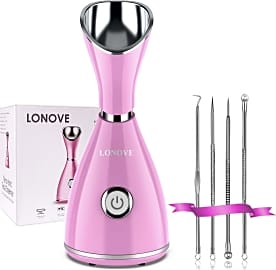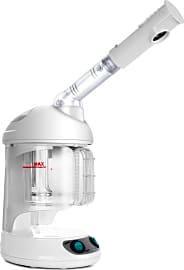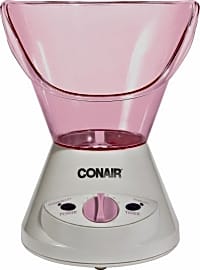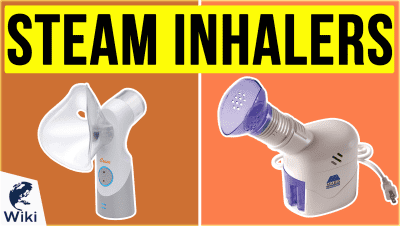The 10 Best Facial Steamers

This wiki has been updated 40 times since it was first published in June of 2015. Designed to cleanse your pores, gently soften skin and help remove dead cells, a facial steamer is a great asset for keeping your complexion healthy and moisturized. We've included models in a range of styles and at price points to suit a variety of budgets. Just remember to ensure your safety by maintaining a bit of distance when using these machines, as they can get very hot. When users buy our independently chosen editorial recommendations, we may earn commissions to help fund the Wiki.
Editor's Notes
February 04, 2020:
Since regular visits to the salon can be both time consuming and pricey, you can give yourself convenient at-home facials instead with one of these easy-to-use steamers. We’ve included choices in a full range of prices, from the wheeled, salon-quality Icarus Jocasta FS-11N, all the way down to the highly portable, rechargeable Cooskin Mister, which can fit easily into a pocket or purse.
We added the Lonove Nano Ionic to bring another user-friendly, affordable choice to the mix, and this one comes complete with a set of extraction tools and a headband to keep your hair out of the way during steaming. It won’t take up much room on your countertop, which is important for those with small bathrooms, and most importantly, it leaves you with smooth, moisturized skin.
Another new addition is the Panasonic Spa Cleansing, which also won’t compete for much vanity room, and the cord conveniently removes for easy storage when you’re done with it. It weighs less than many others, at less then two pounds, and is backed by a 2-year warranty, so you can buy it with confidence.
We kept the Okachi Gliya Mini in the top spot on the list in this update, since it’s hard to be beat for reliability and style. It boasts a durable ceramic heating element that will have soothing steam coming out in no time. Unlike any of the others on our list, it comes with a handy flip-up mirror that’s attached, for anyone who would like a look at their skin during the treatment. It features an 80-milliliter water tank and automatically shuts off once the tank is empty, for safety.
Speaking of safety, always exercise caution with these devices, as they can get very hot. Keep your skin at a safe enough distance so it does not get burned, and be sure to keep them away from children, to avoid injury to them. Anyone with a chronic breathing condition should check with their doctor before attempting to use one of these.
If you want more options, or maybe are looking for one geared to open up the sinuses, check out our list of best steam inhalers, which are great for easing the symptoms of a sore throat and clearing nasal passages.
How A Facial Steamer Works
Next, you place the mask over the base chamber — it should fit snugly into it so you don’t need to hold it.
Facial steamers are simple mechanisms that provide you with a spa-quality experience at home. Most skin types and conditions can benefit from the use of one, because they deeply moisturize the skin, removing dead cells that trap bacteria and cause acne. Facial steamers also open the pores, helping your skin absorb products. The heat of the steamer boosts circulation in your face, just like a sauna increases your body’s circulation. This is important for glowing skin, which is why many dermatologists recommend skin exercises focused on improving skin circulation.
Every facial steamer model you buy will have a water chamber and a mask, but some have advanced features like special mist settings, oversized water tanks, or oxygen-infused steam. If yours does not specify that it has an oversized water tank, then it can probably only deliver between 10 and 30 minutes of steam; models with oversized tanks can provide a full hour. Your first step is pouring water into the water chamber, along with any essential oils or products. Next, you place the mask over the base chamber — it should fit snugly into it so you don’t need to hold it. Power on the machine and the water will heat up, producing steam. Most machines heat water up to 110 degrees Fahrenheit, so it’s very important that you not touch the water as it could potentially cause a burn.
While you wait for your steamer to fully heat the water, drape a towel around your shoulders. Once it’s ready, place your face directly over the mask, with the edges of the mask pressing against your cheeks, forehead, and chin. Lift the towel above your head, to trap escaping steam. Only hold your face in the mask for as long as you are comfortable. Each time you pull your face away, blot it with a towel to remove excess moisture. When you are finished, rinse your face with cold water. This is a great time to apply product because your skin will soak it up readily.
The Best Essential Oils To Add To Your Steamer
Holistic healers and skin care specialists utilize essential oils in the treatment of various ailments, from stress to digestive issues to acne. These oils come from natural sources and won’t cause the dependency issues chemically-created products can. If you already apply essential oils or herbs to your skin, you can reap their benefits even more by adding them to your steamer.
If you already apply essential oils or herbs to your skin, you can reap their benefits even more by adding them to your steamer.
Carrot seed oil helps with cell regeneration, so it can reduce the appearance of scars, sun spots and other imperfections. Geranium oil regulates oil production and can reduce it in oily skin, preventing acne breakouts, or increase it in dry skin, smoothing out wrinkles. Geranium also improves blood flow so it can heal bruises, cuts and broken capillaries. Myrrh oil has anti-inflammatory properties and can improve skin tone, as well as minimize fine lines. It’s also effective in treating eczema.
Neroli oil contains a naturally occurring chemical called citral, which can prevent sagging and reduce the appearance of stretch marks. People suffering from more severe conditions, like dermatitis or psoriasis, benefit from patchouli oil, because it has antiseptic, antifungal and antibacterial properties. Rose oil is particularly good for adding to your steamer. Studies have found that inhaling it can reduce water loss in your skin, helping it keep its natural moisture.
The History Of Steam And Beauty
The Ancient Greeks and Romans of 6th century BC were the first to harness the beauty benefits of steam. Their methods were similar to those of face steaming; they would sit in hot, vaulted rooms filled with water before rinsing off in cold water, and covering themselves in aromatic oils. The Greek philosopher Homer wrote of several popular steam-based rituals, including hot-air baths and hot water tubs. His culture was obsessed with cleansing the body daily, as a way of paying homage to the Gods.
The Greek philosopher Homer wrote of several popular steam-based rituals, including hot-air baths and hot water tubs.
The Spartans invented the first vapor baths, which would inspire modern day steam rooms. They used many of the ingredients that we derive essential oils from, like juniper, bay laurel, fir, and pine. They also drank hot tea to enhance sweat production. Greek bathhouses served as social settings where locals would bathe, relax and talk all day. Because of their elevated status in ancient Greek society, the houses were elaborately adorned with colorful tiles and murals.
In 300 CE, the Romans built the Baths of Diocletian, the largest bath house in the world. The baths spanned 1.5 million square feet and accommodated 3,000 to 6,000 bathers. The Baths of Diocletian flaunted some of Rome’s more advanced technologies, like aqueducts that filled the baths with water, hypocausts that channeled the hot air and smoke from the furnace through hollow chambers below the bathhouse floors, and vaulted ceilings that supported the heavy roofs necessary to insulate the rooms and trap the steam.















